Accounting and Financial Reporting: A Case Study of Brambles Ltd Hedge
VerifiedAdded on 2023/03/31
|11
|1873
|320
Report
AI Summary
This report provides an analysis of the hedge instruments used by Brambles Ltd, an ASX-listed company, focusing on the concept of hedging and its advantages and disadvantages. It identifies the derivative financial instrument reported by Brambles as a hedge, examining the criteria used to ...
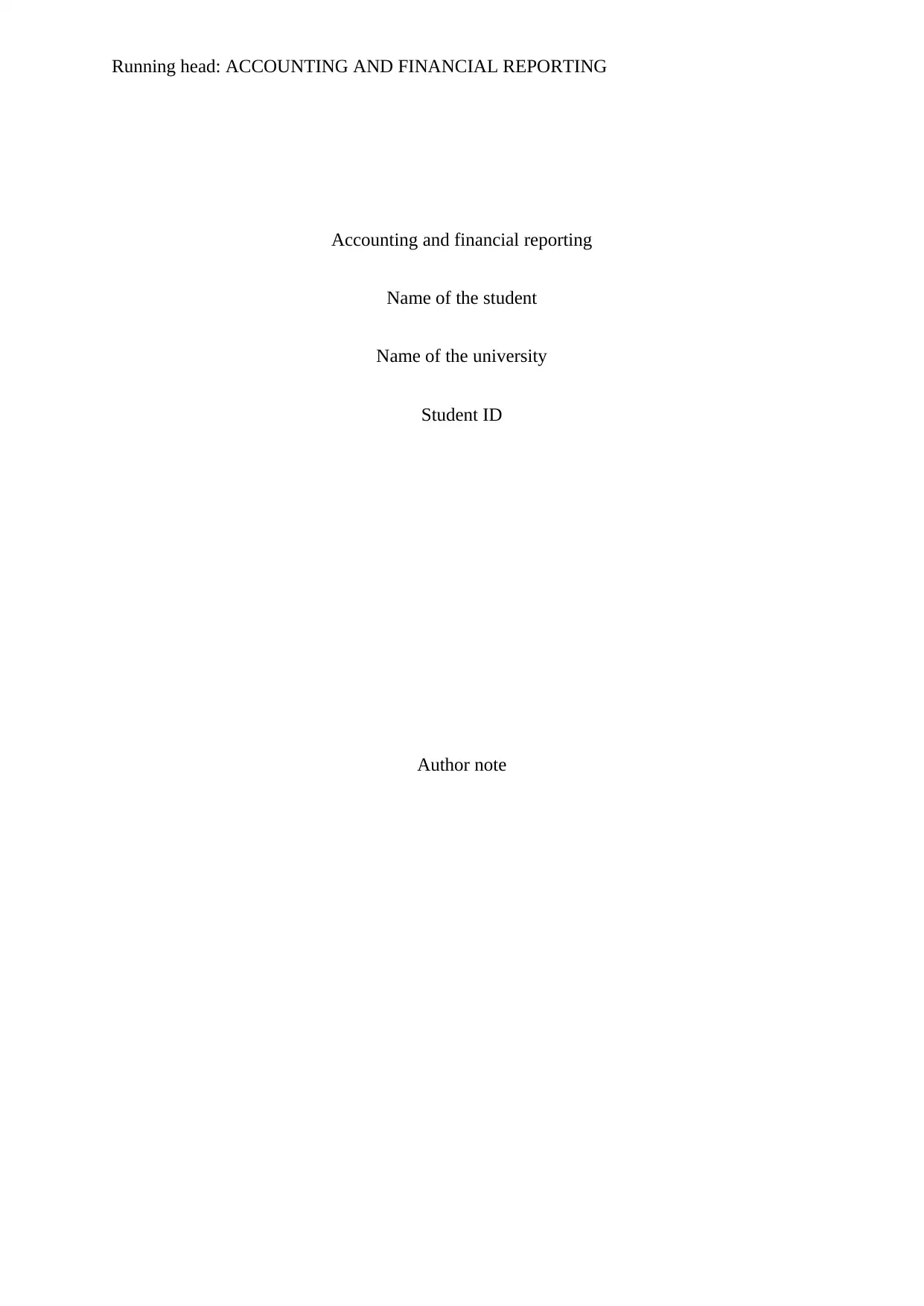
Running head: ACCOUNTING AND FINANCIAL REPORTING
Accounting and financial reporting
Name of the student
Name of the university
Student ID
Author note
Accounting and financial reporting
Name of the student
Name of the university
Student ID
Author note
Paraphrase This Document
Need a fresh take? Get an instant paraphrase of this document with our AI Paraphraser
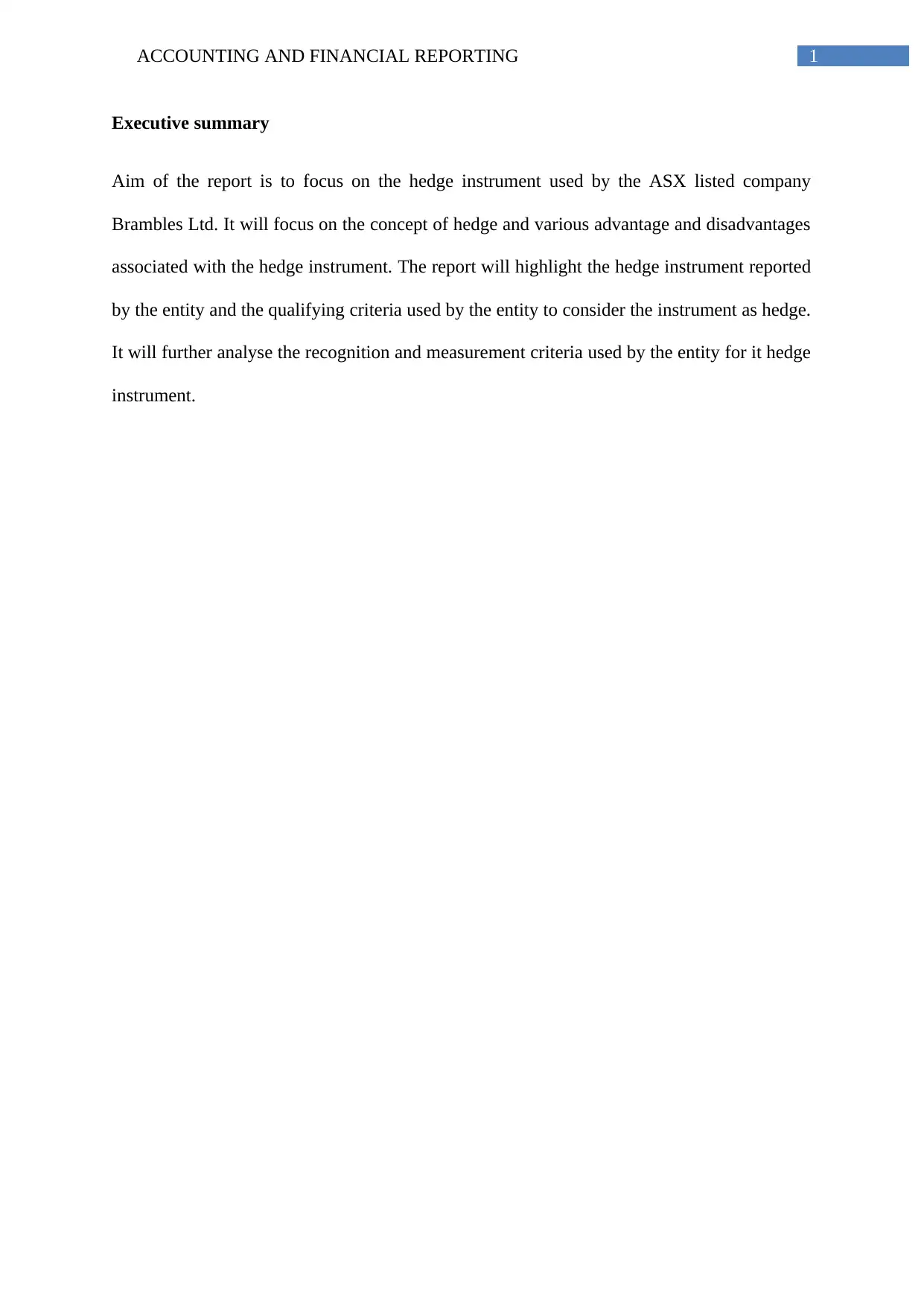
1ACCOUNTING AND FINANCIAL REPORTING
Executive summary
Aim of the report is to focus on the hedge instrument used by the ASX listed company
Brambles Ltd. It will focus on the concept of hedge and various advantage and disadvantages
associated with the hedge instrument. The report will highlight the hedge instrument reported
by the entity and the qualifying criteria used by the entity to consider the instrument as hedge.
It will further analyse the recognition and measurement criteria used by the entity for it hedge
instrument.
Executive summary
Aim of the report is to focus on the hedge instrument used by the ASX listed company
Brambles Ltd. It will focus on the concept of hedge and various advantage and disadvantages
associated with the hedge instrument. The report will highlight the hedge instrument reported
by the entity and the qualifying criteria used by the entity to consider the instrument as hedge.
It will further analyse the recognition and measurement criteria used by the entity for it hedge
instrument.
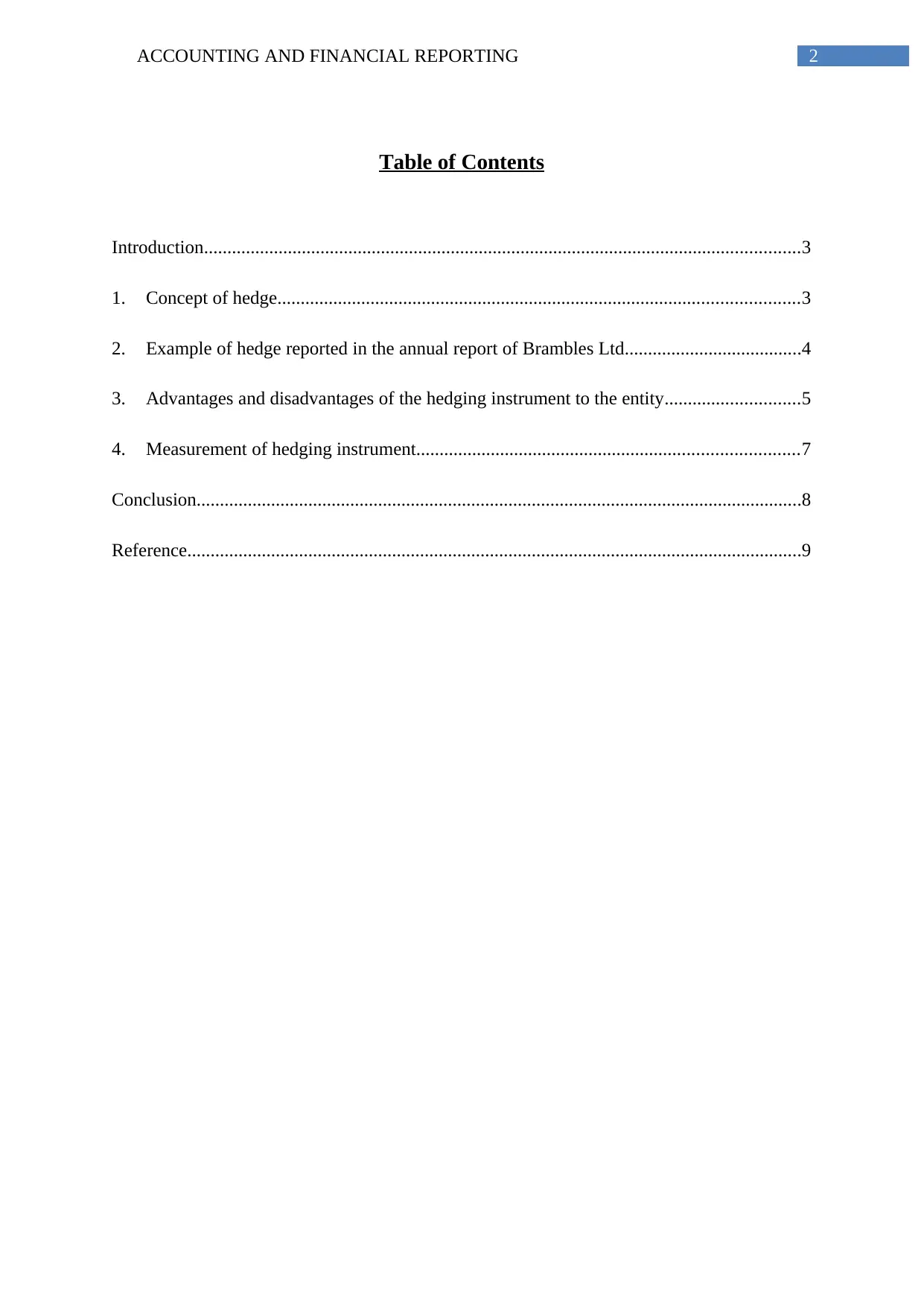
2ACCOUNTING AND FINANCIAL REPORTING
Table of Contents
Introduction................................................................................................................................3
1. Concept of hedge................................................................................................................3
2. Example of hedge reported in the annual report of Brambles Ltd......................................4
3. Advantages and disadvantages of the hedging instrument to the entity.............................5
4. Measurement of hedging instrument..................................................................................7
Conclusion..................................................................................................................................8
Reference....................................................................................................................................9
Table of Contents
Introduction................................................................................................................................3
1. Concept of hedge................................................................................................................3
2. Example of hedge reported in the annual report of Brambles Ltd......................................4
3. Advantages and disadvantages of the hedging instrument to the entity.............................5
4. Measurement of hedging instrument..................................................................................7
Conclusion..................................................................................................................................8
Reference....................................................................................................................................9
You're viewing a preview
Unlock full access by subscribing today!
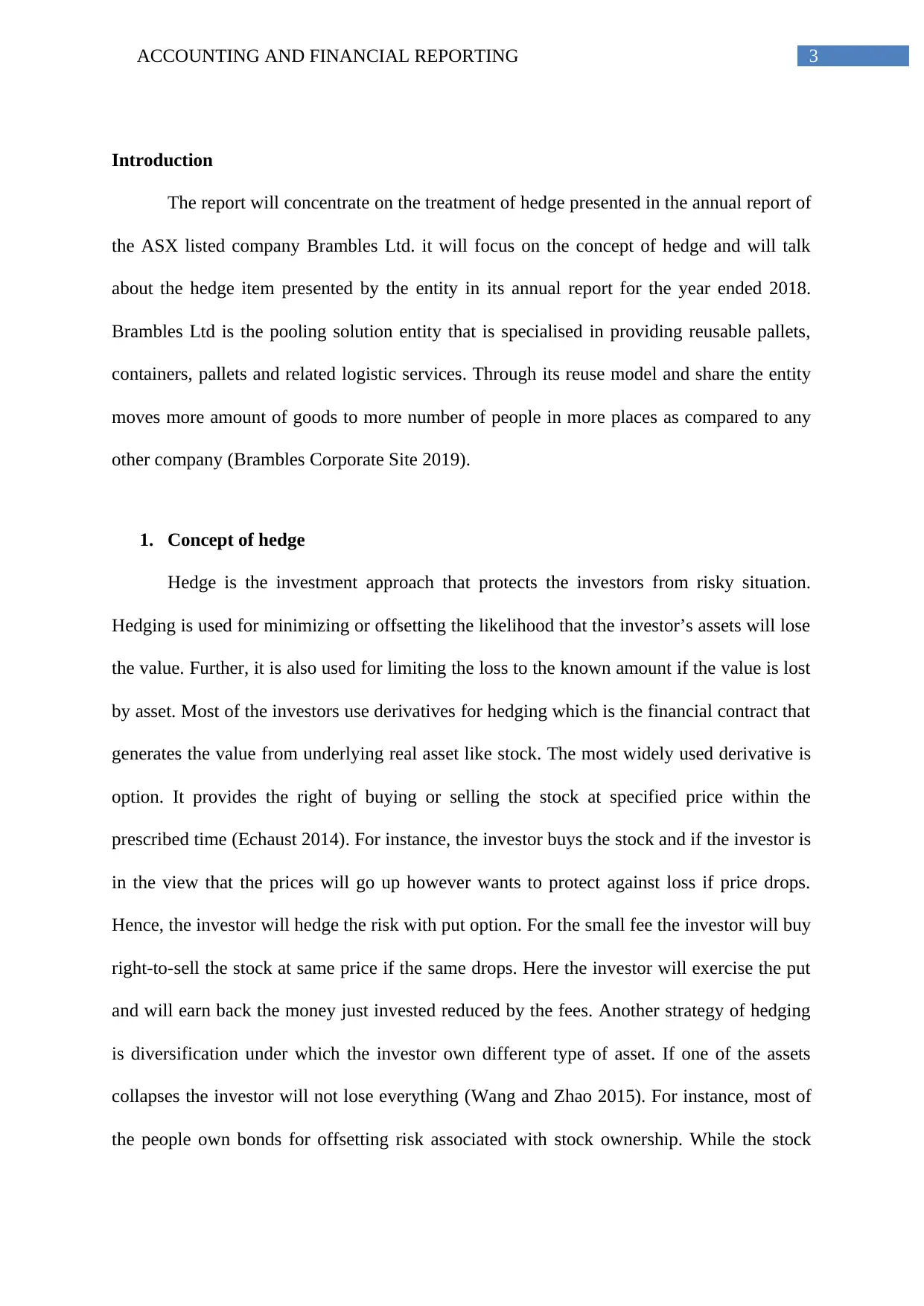
3ACCOUNTING AND FINANCIAL REPORTING
Introduction
The report will concentrate on the treatment of hedge presented in the annual report of
the ASX listed company Brambles Ltd. it will focus on the concept of hedge and will talk
about the hedge item presented by the entity in its annual report for the year ended 2018.
Brambles Ltd is the pooling solution entity that is specialised in providing reusable pallets,
containers, pallets and related logistic services. Through its reuse model and share the entity
moves more amount of goods to more number of people in more places as compared to any
other company (Brambles Corporate Site 2019).
1. Concept of hedge
Hedge is the investment approach that protects the investors from risky situation.
Hedging is used for minimizing or offsetting the likelihood that the investor’s assets will lose
the value. Further, it is also used for limiting the loss to the known amount if the value is lost
by asset. Most of the investors use derivatives for hedging which is the financial contract that
generates the value from underlying real asset like stock. The most widely used derivative is
option. It provides the right of buying or selling the stock at specified price within the
prescribed time (Echaust 2014). For instance, the investor buys the stock and if the investor is
in the view that the prices will go up however wants to protect against loss if price drops.
Hence, the investor will hedge the risk with put option. For the small fee the investor will buy
right-to-sell the stock at same price if the same drops. Here the investor will exercise the put
and will earn back the money just invested reduced by the fees. Another strategy of hedging
is diversification under which the investor own different type of asset. If one of the assets
collapses the investor will not lose everything (Wang and Zhao 2015). For instance, most of
the people own bonds for offsetting risk associated with stock ownership. While the stock
Introduction
The report will concentrate on the treatment of hedge presented in the annual report of
the ASX listed company Brambles Ltd. it will focus on the concept of hedge and will talk
about the hedge item presented by the entity in its annual report for the year ended 2018.
Brambles Ltd is the pooling solution entity that is specialised in providing reusable pallets,
containers, pallets and related logistic services. Through its reuse model and share the entity
moves more amount of goods to more number of people in more places as compared to any
other company (Brambles Corporate Site 2019).
1. Concept of hedge
Hedge is the investment approach that protects the investors from risky situation.
Hedging is used for minimizing or offsetting the likelihood that the investor’s assets will lose
the value. Further, it is also used for limiting the loss to the known amount if the value is lost
by asset. Most of the investors use derivatives for hedging which is the financial contract that
generates the value from underlying real asset like stock. The most widely used derivative is
option. It provides the right of buying or selling the stock at specified price within the
prescribed time (Echaust 2014). For instance, the investor buys the stock and if the investor is
in the view that the prices will go up however wants to protect against loss if price drops.
Hence, the investor will hedge the risk with put option. For the small fee the investor will buy
right-to-sell the stock at same price if the same drops. Here the investor will exercise the put
and will earn back the money just invested reduced by the fees. Another strategy of hedging
is diversification under which the investor own different type of asset. If one of the assets
collapses the investor will not lose everything (Wang and Zhao 2015). For instance, most of
the people own bonds for offsetting risk associated with stock ownership. While the stock
Paraphrase This Document
Need a fresh take? Get an instant paraphrase of this document with our AI Paraphraser
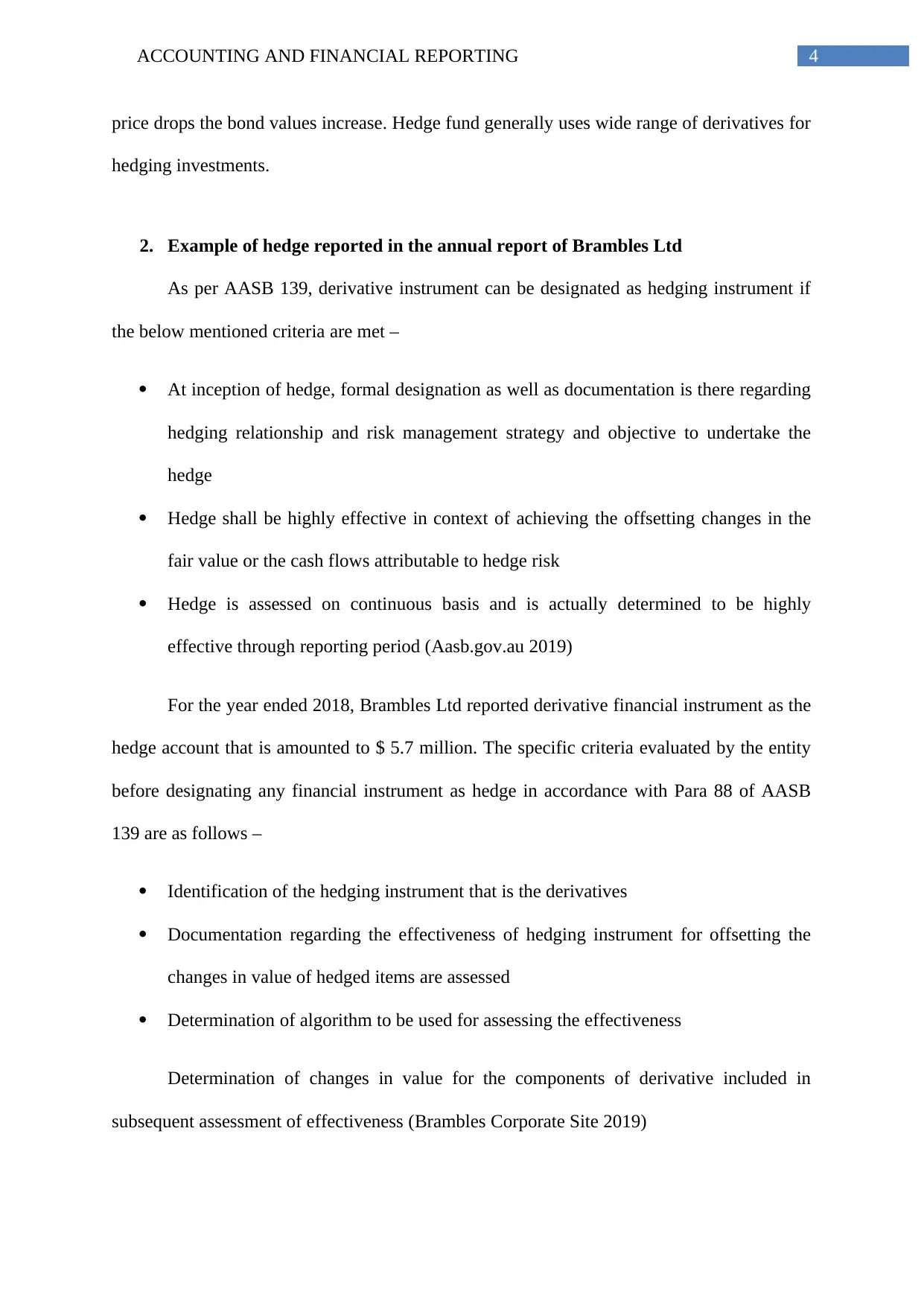
4ACCOUNTING AND FINANCIAL REPORTING
price drops the bond values increase. Hedge fund generally uses wide range of derivatives for
hedging investments.
2. Example of hedge reported in the annual report of Brambles Ltd
As per AASB 139, derivative instrument can be designated as hedging instrument if
the below mentioned criteria are met –
At inception of hedge, formal designation as well as documentation is there regarding
hedging relationship and risk management strategy and objective to undertake the
hedge
Hedge shall be highly effective in context of achieving the offsetting changes in the
fair value or the cash flows attributable to hedge risk
Hedge is assessed on continuous basis and is actually determined to be highly
effective through reporting period (Aasb.gov.au 2019)
For the year ended 2018, Brambles Ltd reported derivative financial instrument as the
hedge account that is amounted to $ 5.7 million. The specific criteria evaluated by the entity
before designating any financial instrument as hedge in accordance with Para 88 of AASB
139 are as follows –
Identification of the hedging instrument that is the derivatives
Documentation regarding the effectiveness of hedging instrument for offsetting the
changes in value of hedged items are assessed
Determination of algorithm to be used for assessing the effectiveness
Determination of changes in value for the components of derivative included in
subsequent assessment of effectiveness (Brambles Corporate Site 2019)
price drops the bond values increase. Hedge fund generally uses wide range of derivatives for
hedging investments.
2. Example of hedge reported in the annual report of Brambles Ltd
As per AASB 139, derivative instrument can be designated as hedging instrument if
the below mentioned criteria are met –
At inception of hedge, formal designation as well as documentation is there regarding
hedging relationship and risk management strategy and objective to undertake the
hedge
Hedge shall be highly effective in context of achieving the offsetting changes in the
fair value or the cash flows attributable to hedge risk
Hedge is assessed on continuous basis and is actually determined to be highly
effective through reporting period (Aasb.gov.au 2019)
For the year ended 2018, Brambles Ltd reported derivative financial instrument as the
hedge account that is amounted to $ 5.7 million. The specific criteria evaluated by the entity
before designating any financial instrument as hedge in accordance with Para 88 of AASB
139 are as follows –
Identification of the hedging instrument that is the derivatives
Documentation regarding the effectiveness of hedging instrument for offsetting the
changes in value of hedged items are assessed
Determination of algorithm to be used for assessing the effectiveness
Determination of changes in value for the components of derivative included in
subsequent assessment of effectiveness (Brambles Corporate Site 2019)
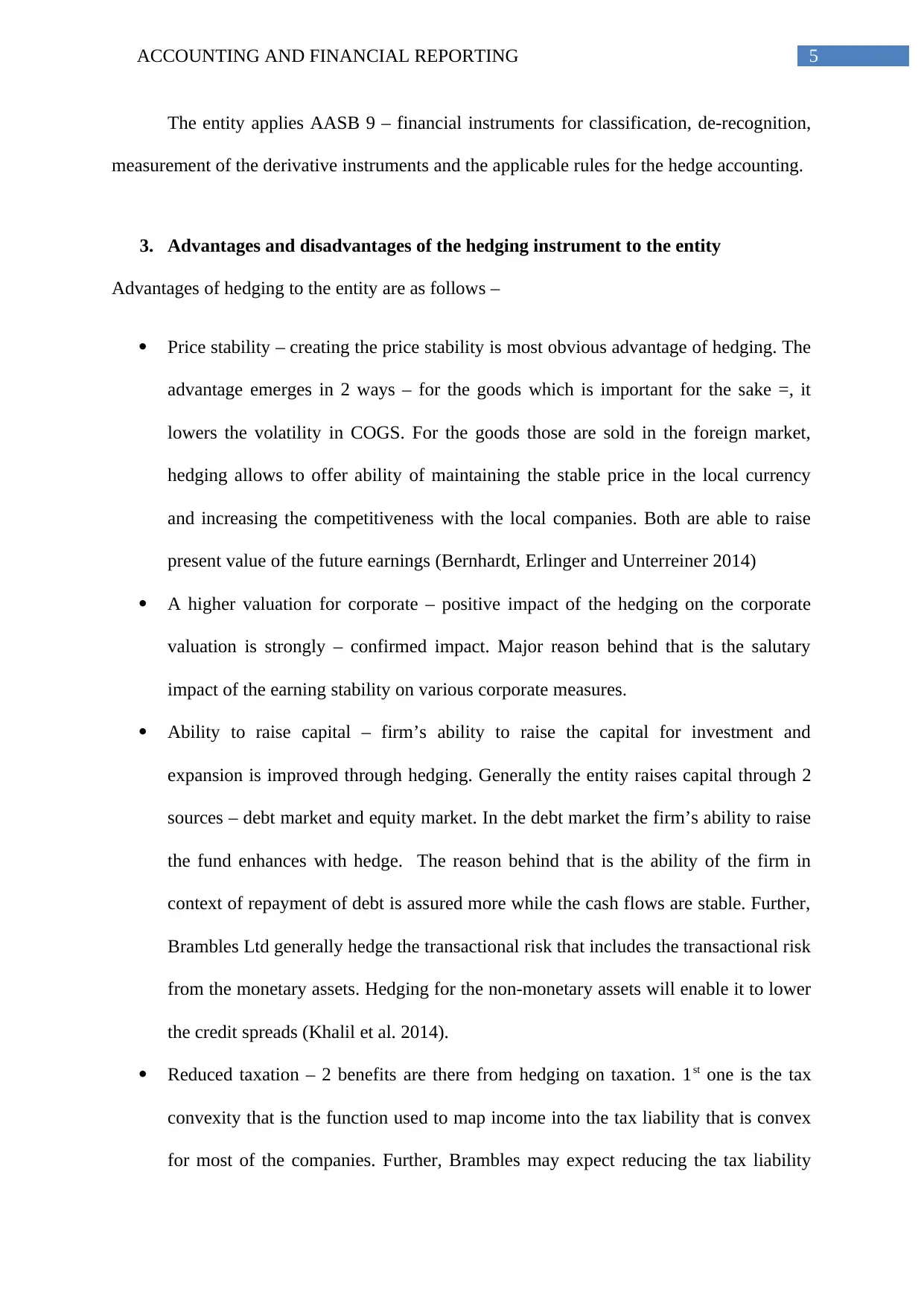
5ACCOUNTING AND FINANCIAL REPORTING
The entity applies AASB 9 – financial instruments for classification, de-recognition,
measurement of the derivative instruments and the applicable rules for the hedge accounting.
3. Advantages and disadvantages of the hedging instrument to the entity
Advantages of hedging to the entity are as follows –
Price stability – creating the price stability is most obvious advantage of hedging. The
advantage emerges in 2 ways – for the goods which is important for the sake =, it
lowers the volatility in COGS. For the goods those are sold in the foreign market,
hedging allows to offer ability of maintaining the stable price in the local currency
and increasing the competitiveness with the local companies. Both are able to raise
present value of the future earnings (Bernhardt, Erlinger and Unterreiner 2014)
A higher valuation for corporate – positive impact of the hedging on the corporate
valuation is strongly – confirmed impact. Major reason behind that is the salutary
impact of the earning stability on various corporate measures.
Ability to raise capital – firm’s ability to raise the capital for investment and
expansion is improved through hedging. Generally the entity raises capital through 2
sources – debt market and equity market. In the debt market the firm’s ability to raise
the fund enhances with hedge. The reason behind that is the ability of the firm in
context of repayment of debt is assured more while the cash flows are stable. Further,
Brambles Ltd generally hedge the transactional risk that includes the transactional risk
from the monetary assets. Hedging for the non-monetary assets will enable it to lower
the credit spreads (Khalil et al. 2014).
Reduced taxation – 2 benefits are there from hedging on taxation. 1st one is the tax
convexity that is the function used to map income into the tax liability that is convex
for most of the companies. Further, Brambles may expect reducing the tax liability
The entity applies AASB 9 – financial instruments for classification, de-recognition,
measurement of the derivative instruments and the applicable rules for the hedge accounting.
3. Advantages and disadvantages of the hedging instrument to the entity
Advantages of hedging to the entity are as follows –
Price stability – creating the price stability is most obvious advantage of hedging. The
advantage emerges in 2 ways – for the goods which is important for the sake =, it
lowers the volatility in COGS. For the goods those are sold in the foreign market,
hedging allows to offer ability of maintaining the stable price in the local currency
and increasing the competitiveness with the local companies. Both are able to raise
present value of the future earnings (Bernhardt, Erlinger and Unterreiner 2014)
A higher valuation for corporate – positive impact of the hedging on the corporate
valuation is strongly – confirmed impact. Major reason behind that is the salutary
impact of the earning stability on various corporate measures.
Ability to raise capital – firm’s ability to raise the capital for investment and
expansion is improved through hedging. Generally the entity raises capital through 2
sources – debt market and equity market. In the debt market the firm’s ability to raise
the fund enhances with hedge. The reason behind that is the ability of the firm in
context of repayment of debt is assured more while the cash flows are stable. Further,
Brambles Ltd generally hedge the transactional risk that includes the transactional risk
from the monetary assets. Hedging for the non-monetary assets will enable it to lower
the credit spreads (Khalil et al. 2014).
Reduced taxation – 2 benefits are there from hedging on taxation. 1st one is the tax
convexity that is the function used to map income into the tax liability that is convex
for most of the companies. Further, Brambles may expect reducing the tax liability
You're viewing a preview
Unlock full access by subscribing today!
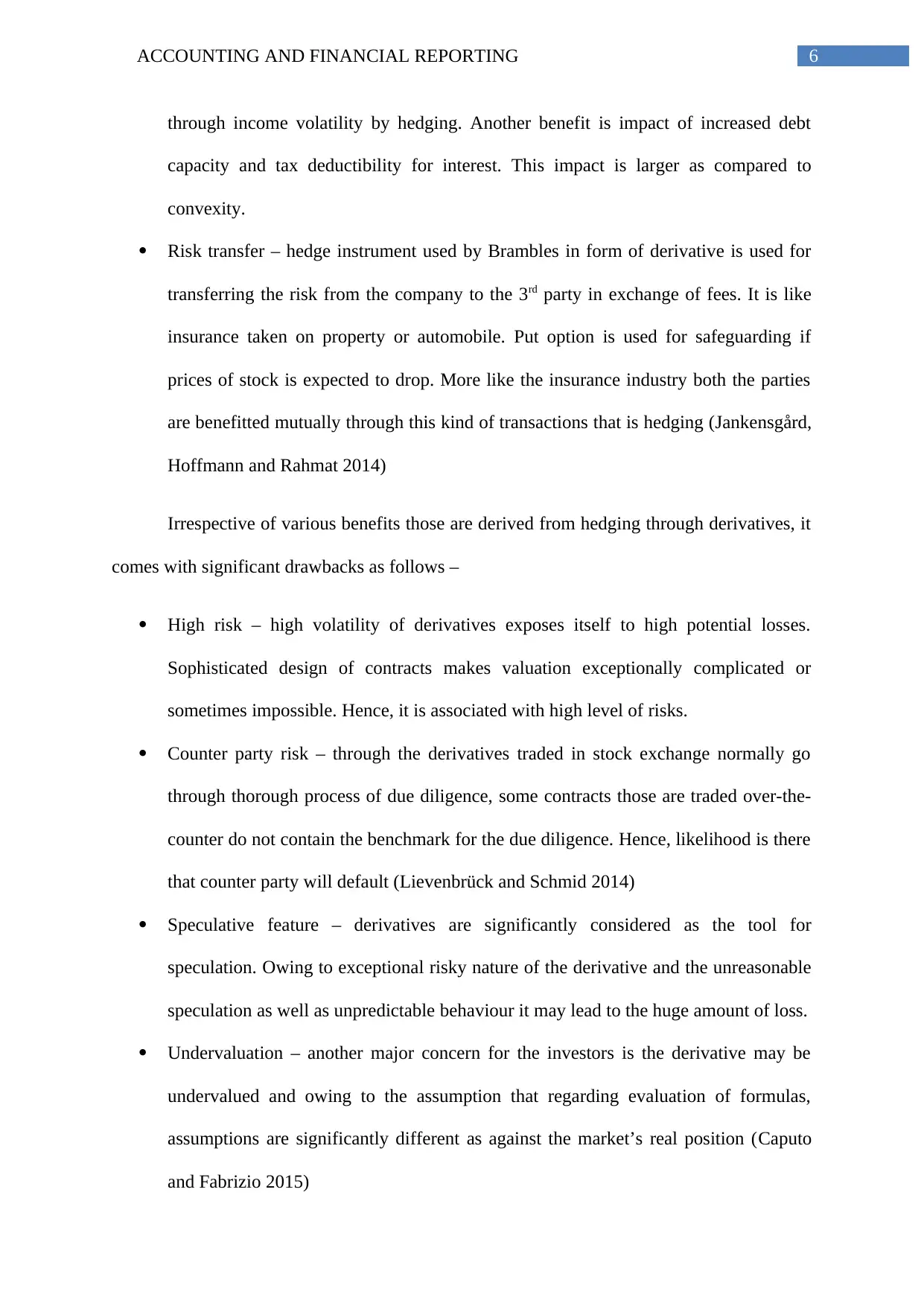
6ACCOUNTING AND FINANCIAL REPORTING
through income volatility by hedging. Another benefit is impact of increased debt
capacity and tax deductibility for interest. This impact is larger as compared to
convexity.
Risk transfer – hedge instrument used by Brambles in form of derivative is used for
transferring the risk from the company to the 3rd party in exchange of fees. It is like
insurance taken on property or automobile. Put option is used for safeguarding if
prices of stock is expected to drop. More like the insurance industry both the parties
are benefitted mutually through this kind of transactions that is hedging (Jankensgård,
Hoffmann and Rahmat 2014)
Irrespective of various benefits those are derived from hedging through derivatives, it
comes with significant drawbacks as follows –
High risk – high volatility of derivatives exposes itself to high potential losses.
Sophisticated design of contracts makes valuation exceptionally complicated or
sometimes impossible. Hence, it is associated with high level of risks.
Counter party risk – through the derivatives traded in stock exchange normally go
through thorough process of due diligence, some contracts those are traded over-the-
counter do not contain the benchmark for the due diligence. Hence, likelihood is there
that counter party will default (Lievenbrück and Schmid 2014)
Speculative feature – derivatives are significantly considered as the tool for
speculation. Owing to exceptional risky nature of the derivative and the unreasonable
speculation as well as unpredictable behaviour it may lead to the huge amount of loss.
Undervaluation – another major concern for the investors is the derivative may be
undervalued and owing to the assumption that regarding evaluation of formulas,
assumptions are significantly different as against the market’s real position (Caputo
and Fabrizio 2015)
through income volatility by hedging. Another benefit is impact of increased debt
capacity and tax deductibility for interest. This impact is larger as compared to
convexity.
Risk transfer – hedge instrument used by Brambles in form of derivative is used for
transferring the risk from the company to the 3rd party in exchange of fees. It is like
insurance taken on property or automobile. Put option is used for safeguarding if
prices of stock is expected to drop. More like the insurance industry both the parties
are benefitted mutually through this kind of transactions that is hedging (Jankensgård,
Hoffmann and Rahmat 2014)
Irrespective of various benefits those are derived from hedging through derivatives, it
comes with significant drawbacks as follows –
High risk – high volatility of derivatives exposes itself to high potential losses.
Sophisticated design of contracts makes valuation exceptionally complicated or
sometimes impossible. Hence, it is associated with high level of risks.
Counter party risk – through the derivatives traded in stock exchange normally go
through thorough process of due diligence, some contracts those are traded over-the-
counter do not contain the benchmark for the due diligence. Hence, likelihood is there
that counter party will default (Lievenbrück and Schmid 2014)
Speculative feature – derivatives are significantly considered as the tool for
speculation. Owing to exceptional risky nature of the derivative and the unreasonable
speculation as well as unpredictable behaviour it may lead to the huge amount of loss.
Undervaluation – another major concern for the investors is the derivative may be
undervalued and owing to the assumption that regarding evaluation of formulas,
assumptions are significantly different as against the market’s real position (Caputo
and Fabrizio 2015)
Paraphrase This Document
Need a fresh take? Get an instant paraphrase of this document with our AI Paraphraser
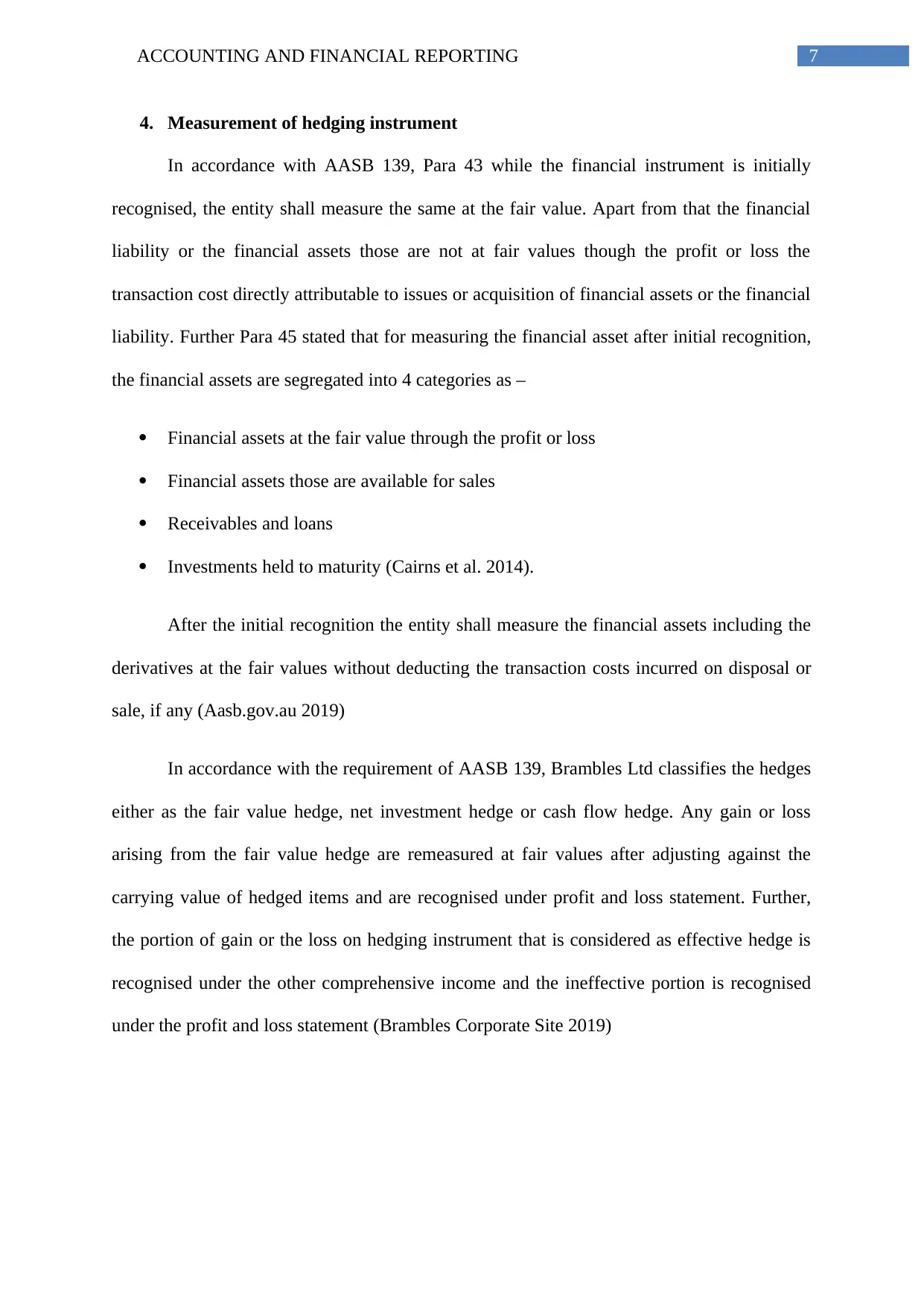
7ACCOUNTING AND FINANCIAL REPORTING
4. Measurement of hedging instrument
In accordance with AASB 139, Para 43 while the financial instrument is initially
recognised, the entity shall measure the same at the fair value. Apart from that the financial
liability or the financial assets those are not at fair values though the profit or loss the
transaction cost directly attributable to issues or acquisition of financial assets or the financial
liability. Further Para 45 stated that for measuring the financial asset after initial recognition,
the financial assets are segregated into 4 categories as –
Financial assets at the fair value through the profit or loss
Financial assets those are available for sales
Receivables and loans
Investments held to maturity (Cairns et al. 2014).
After the initial recognition the entity shall measure the financial assets including the
derivatives at the fair values without deducting the transaction costs incurred on disposal or
sale, if any (Aasb.gov.au 2019)
In accordance with the requirement of AASB 139, Brambles Ltd classifies the hedges
either as the fair value hedge, net investment hedge or cash flow hedge. Any gain or loss
arising from the fair value hedge are remeasured at fair values after adjusting against the
carrying value of hedged items and are recognised under profit and loss statement. Further,
the portion of gain or the loss on hedging instrument that is considered as effective hedge is
recognised under the other comprehensive income and the ineffective portion is recognised
under the profit and loss statement (Brambles Corporate Site 2019)
4. Measurement of hedging instrument
In accordance with AASB 139, Para 43 while the financial instrument is initially
recognised, the entity shall measure the same at the fair value. Apart from that the financial
liability or the financial assets those are not at fair values though the profit or loss the
transaction cost directly attributable to issues or acquisition of financial assets or the financial
liability. Further Para 45 stated that for measuring the financial asset after initial recognition,
the financial assets are segregated into 4 categories as –
Financial assets at the fair value through the profit or loss
Financial assets those are available for sales
Receivables and loans
Investments held to maturity (Cairns et al. 2014).
After the initial recognition the entity shall measure the financial assets including the
derivatives at the fair values without deducting the transaction costs incurred on disposal or
sale, if any (Aasb.gov.au 2019)
In accordance with the requirement of AASB 139, Brambles Ltd classifies the hedges
either as the fair value hedge, net investment hedge or cash flow hedge. Any gain or loss
arising from the fair value hedge are remeasured at fair values after adjusting against the
carrying value of hedged items and are recognised under profit and loss statement. Further,
the portion of gain or the loss on hedging instrument that is considered as effective hedge is
recognised under the other comprehensive income and the ineffective portion is recognised
under the profit and loss statement (Brambles Corporate Site 2019)
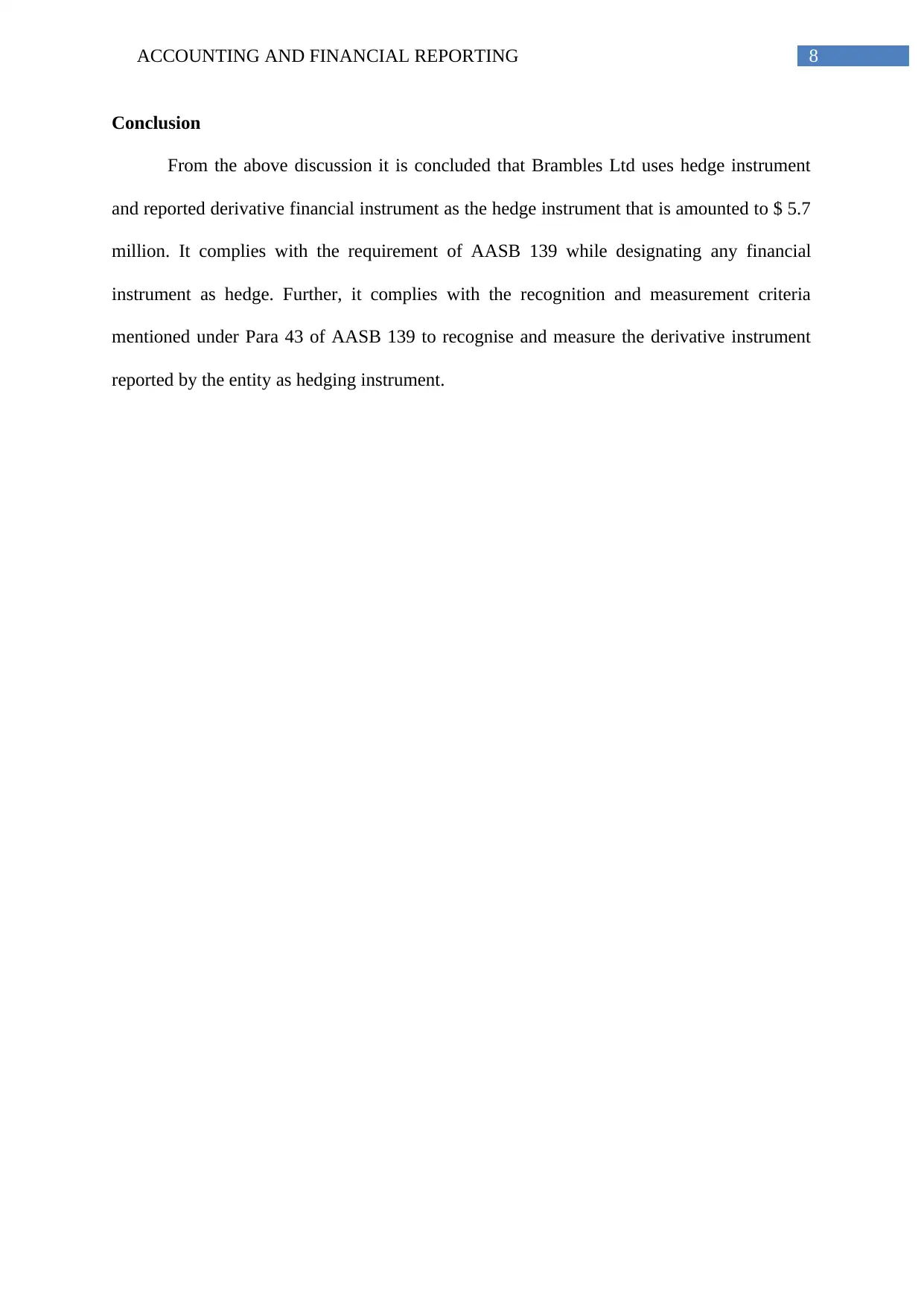
8ACCOUNTING AND FINANCIAL REPORTING
Conclusion
From the above discussion it is concluded that Brambles Ltd uses hedge instrument
and reported derivative financial instrument as the hedge instrument that is amounted to $ 5.7
million. It complies with the requirement of AASB 139 while designating any financial
instrument as hedge. Further, it complies with the recognition and measurement criteria
mentioned under Para 43 of AASB 139 to recognise and measure the derivative instrument
reported by the entity as hedging instrument.
Conclusion
From the above discussion it is concluded that Brambles Ltd uses hedge instrument
and reported derivative financial instrument as the hedge instrument that is amounted to $ 5.7
million. It complies with the requirement of AASB 139 while designating any financial
instrument as hedge. Further, it complies with the recognition and measurement criteria
mentioned under Para 43 of AASB 139 to recognise and measure the derivative instrument
reported by the entity as hedging instrument.
You're viewing a preview
Unlock full access by subscribing today!
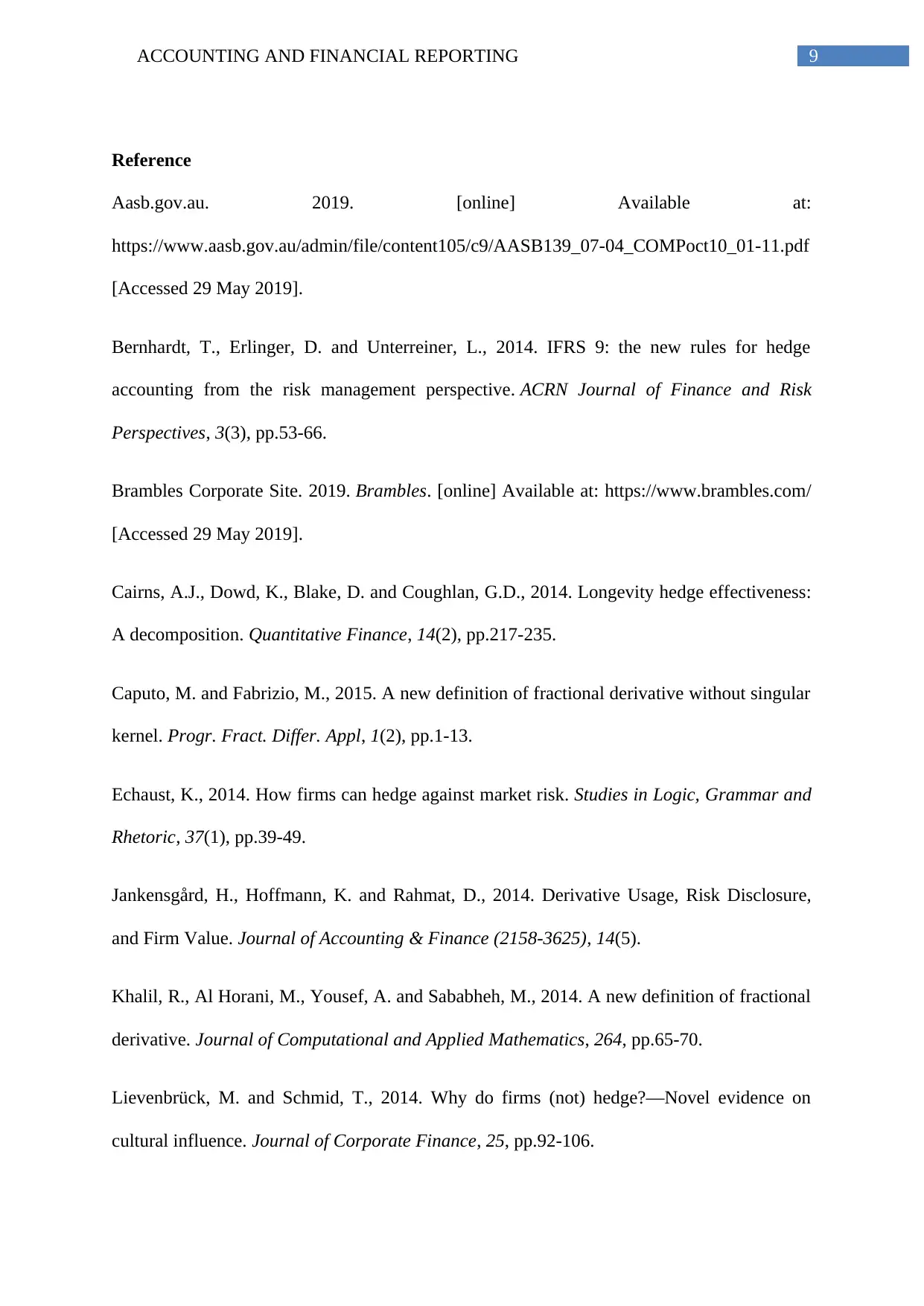
9ACCOUNTING AND FINANCIAL REPORTING
Reference
Aasb.gov.au. 2019. [online] Available at:
https://www.aasb.gov.au/admin/file/content105/c9/AASB139_07-04_COMPoct10_01-11.pdf
[Accessed 29 May 2019].
Bernhardt, T., Erlinger, D. and Unterreiner, L., 2014. IFRS 9: the new rules for hedge
accounting from the risk management perspective. ACRN Journal of Finance and Risk
Perspectives, 3(3), pp.53-66.
Brambles Corporate Site. 2019. Brambles. [online] Available at: https://www.brambles.com/
[Accessed 29 May 2019].
Cairns, A.J., Dowd, K., Blake, D. and Coughlan, G.D., 2014. Longevity hedge effectiveness:
A decomposition. Quantitative Finance, 14(2), pp.217-235.
Caputo, M. and Fabrizio, M., 2015. A new definition of fractional derivative without singular
kernel. Progr. Fract. Differ. Appl, 1(2), pp.1-13.
Echaust, K., 2014. How firms can hedge against market risk. Studies in Logic, Grammar and
Rhetoric, 37(1), pp.39-49.
Jankensgård, H., Hoffmann, K. and Rahmat, D., 2014. Derivative Usage, Risk Disclosure,
and Firm Value. Journal of Accounting & Finance (2158-3625), 14(5).
Khalil, R., Al Horani, M., Yousef, A. and Sababheh, M., 2014. A new definition of fractional
derivative. Journal of Computational and Applied Mathematics, 264, pp.65-70.
Lievenbrück, M. and Schmid, T., 2014. Why do firms (not) hedge?—Novel evidence on
cultural influence. Journal of Corporate Finance, 25, pp.92-106.
Reference
Aasb.gov.au. 2019. [online] Available at:
https://www.aasb.gov.au/admin/file/content105/c9/AASB139_07-04_COMPoct10_01-11.pdf
[Accessed 29 May 2019].
Bernhardt, T., Erlinger, D. and Unterreiner, L., 2014. IFRS 9: the new rules for hedge
accounting from the risk management perspective. ACRN Journal of Finance and Risk
Perspectives, 3(3), pp.53-66.
Brambles Corporate Site. 2019. Brambles. [online] Available at: https://www.brambles.com/
[Accessed 29 May 2019].
Cairns, A.J., Dowd, K., Blake, D. and Coughlan, G.D., 2014. Longevity hedge effectiveness:
A decomposition. Quantitative Finance, 14(2), pp.217-235.
Caputo, M. and Fabrizio, M., 2015. A new definition of fractional derivative without singular
kernel. Progr. Fract. Differ. Appl, 1(2), pp.1-13.
Echaust, K., 2014. How firms can hedge against market risk. Studies in Logic, Grammar and
Rhetoric, 37(1), pp.39-49.
Jankensgård, H., Hoffmann, K. and Rahmat, D., 2014. Derivative Usage, Risk Disclosure,
and Firm Value. Journal of Accounting & Finance (2158-3625), 14(5).
Khalil, R., Al Horani, M., Yousef, A. and Sababheh, M., 2014. A new definition of fractional
derivative. Journal of Computational and Applied Mathematics, 264, pp.65-70.
Lievenbrück, M. and Schmid, T., 2014. Why do firms (not) hedge?—Novel evidence on
cultural influence. Journal of Corporate Finance, 25, pp.92-106.
Paraphrase This Document
Need a fresh take? Get an instant paraphrase of this document with our AI Paraphraser

10ACCOUNTING AND FINANCIAL REPORTING
Wang, Y. and Zhao, J., 2015. Hedge funds and corporate innovation. Financial
Management, 44(2), pp.353-385.
Wang, Y. and Zhao, J., 2015. Hedge funds and corporate innovation. Financial
Management, 44(2), pp.353-385.
1 out of 11
Related Documents
Your All-in-One AI-Powered Toolkit for Academic Success.
+13062052269
info@desklib.com
Available 24*7 on WhatsApp / Email
![[object Object]](/_next/static/media/star-bottom.7253800d.svg)
Unlock your academic potential
© 2024 | Zucol Services PVT LTD | All rights reserved.




